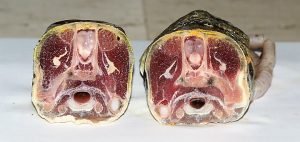Morfofisiologia da glândula de sal de tartaruga verde Chelonia mydas (Linnaeus, 1758)
artigo glandula de sal tartaruga verde
ABSTRACT
In the group of reptiles there are many marine species whose foods have high concentration of salts
getting with the blood plasma very concentrated. Turtles, lizards and sea birds have salt glands that,
through active transport, excrete excess ingested salt. The objective of this study was to describe the
morphology of green – turtle salt glands (Cheloniamydas). The salt gland was removed and analyzed
macroscopically and microscopically by light microscopy and scanning electron microscopy.
Macroscopically, the salt glands are paired in the hind laterally region of the eyes, with a reddishbrown
color and lobulated appearance. In the most apical region of the gland its shape is concave
adhered to the eye and in the basal region is triangular. Microscopically it was observed that the
lobes are separated by blood vessels and connective tissue. The glands have simple tubular glandular
tissue that emerge into a central duct. Morphological findings suggest that this gland helps blood
osmoregulation by aiding renal function, where excess salt is transported into the cells via osmosis,
which in turn releases via exocytosis, into the canalicular lumen.
Keywords: osmoregulation, turtles, morphology, scanning electron microscopy, glandular tissue.
http://ibimm.org.br/morfofisiologia-da-glandula-de-sal-de-tartaruga-verde-chelonia-mydas-linnaeus-1758/PRODUÇÕES CIENTÍFICAS IBIMMartigo glandula de sal tartaruga verde ABSTRACT In the group of reptiles there are many marine species whose foods have high concentration of salts getting with the blood plasma very concentrated. Turtles, lizards and sea birds have salt glands that, through active transport, excrete excess ingested salt. The objective of this study was...IBIMMIBIMM INSTITUTO DE BIOLOGIA MARINHA E MEIO AMBIENTEcontatobiologia@ibimm.org.brEditor


